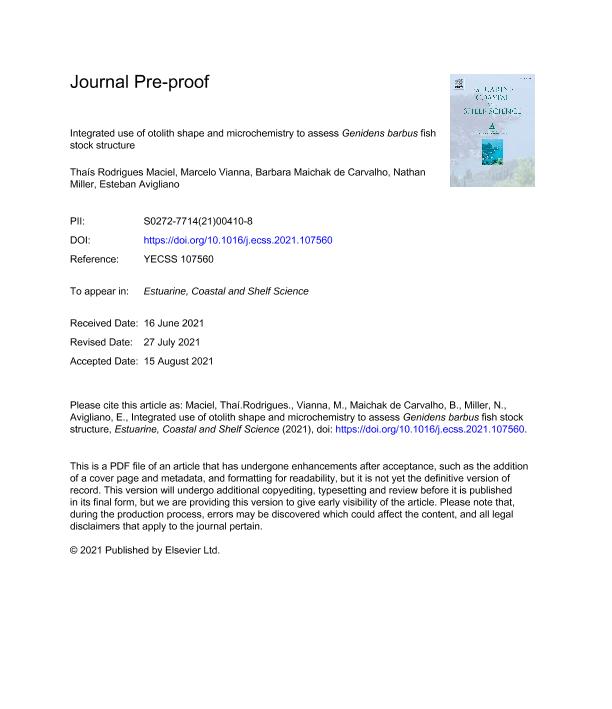Mostrar el registro sencillo del ítem
dc.contributor.author
Rodrigues Maciel, Thaís
dc.contributor.author
Vianna, Marcelo
dc.contributor.author
Maichak de Carvalho, Barbara
dc.contributor.author
Miller, Nathan
dc.contributor.author
Avigliano, Esteban

dc.date.available
2022-08-02T10:19:13Z
dc.date.issued
2021-10
dc.identifier.citation
Rodrigues Maciel, Thaís; Vianna, Marcelo; Maichak de Carvalho, Barbara; Miller, Nathan; Avigliano, Esteban; Integrated use of otolith shape and microchemistry to assess Genidens barbus fish stock structure; Academic Press Ltd - Elsevier Science Ltd; Estuarine, Coastal and Shelf Science; 261; 10-2021; 1-35
dc.identifier.issn
0272-7714
dc.identifier.uri
http://hdl.handle.net/11336/163794
dc.description.abstract
Otolith composition (edge vs core: Mg/Ca, Mn/Ca, Zn/Ca, Sr/Ca, Ba/Ca) by LA-ICP-MS and Elliptic Fourier analysis were integrated to evaluate spatial segregation of adult and juvenile stages of Genidens barbus from specimens collected from five coastal areas off Brazil (Paraíba do Sul River, Guanabara Bay, Itapanhaú River mouth, Paranaguá Bay), Argentina and Uruguay (La Plata Estuary). Fisheries of this diadromous catfish have largely collapsed in the southwest Atlantic coastal region due to overexploitation. An understanding of population structure is now critically needed for improved management strategies for this endangered species. PERMANOVA based on otolith edge chemistry showed significant differences (p < 0.05) between all sites, except Itapanhaú River and Paranaguá Bay. Shape, by comparison, found significant differences between all sampling sites, except Guanabara Bay and Paranaguá Bay, and Itapanhaú River and Paranaguá Bay. Discriminant analysis cross-classification success based on chemistry ranged from 33.3 (Paranaguá Bay) to 100% (La Plata Estuary), and 66.7 (Paranaguá Bay) to 100% (La Plata Estuary) for otolith edges (mean = 61.3%) and cores (mean = 78.9%), respectively. For otolith shape, the jackknifed rate (mean = 45.9%) was relatively low for all sites (32.1–44.7%) except La Plata Estuary (67.6%). Although we do not find otolith shape to be particularly useful; otolith microchemistry supports the presence of different management units. The results revealed that on a small geographic scale (~300 km) microchemistry might not be efficient to discriminate between some sampling sites.
dc.format
application/pdf
dc.language.iso
eng
dc.publisher
Academic Press Ltd - Elsevier Science Ltd

dc.rights
info:eu-repo/semantics/openAccess
dc.rights.uri
https://creativecommons.org/licenses/by-nc-sa/2.5/ar/
dc.subject
CATFISH
dc.subject
ESTUARIES
dc.subject
FISH STOCK
dc.subject
SEGREGATION
dc.subject
TRACE ELEMENTS
dc.subject.classification
Otras Agricultura, Silvicultura y Pesca

dc.subject.classification
Agricultura, Silvicultura y Pesca

dc.subject.classification
CIENCIAS AGRÍCOLAS

dc.title
Integrated use of otolith shape and microchemistry to assess Genidens barbus fish stock structure
dc.type
info:eu-repo/semantics/article
dc.type
info:ar-repo/semantics/artículo
dc.type
info:eu-repo/semantics/publishedVersion
dc.date.updated
2022-02-18T19:46:51Z
dc.journal.volume
261
dc.journal.pagination
1-35
dc.journal.pais
Estados Unidos

dc.description.fil
Fil: Rodrigues Maciel, Thaís. Universidade Federal do Rio de Janeiro; Brasil
dc.description.fil
Fil: Vianna, Marcelo. Universidade Federal do Rio de Janeiro; Brasil
dc.description.fil
Fil: Maichak de Carvalho, Barbara. Universidade Federal do Paraná; Brasil
dc.description.fil
Fil: Miller, Nathan. University of Texas at Austin; Estados Unidos
dc.description.fil
Fil: Avigliano, Esteban. Consejo Nacional de Investigaciones Científicas y Técnicas. Oficina de Coordinación Administrativa Parque Centenario. Unidad Ejecutora de Investigaciones en Producción Animal. Universidad de Buenos Aires. Facultad de Ciencias Veterinarias. Unidad Ejecutora de Investigaciones en Producción Animal; Argentina
dc.journal.title
Estuarine, Coastal and Shelf Science

dc.relation.alternativeid
info:eu-repo/semantics/altIdentifier/url/https://linkinghub.elsevier.com/retrieve/pii/S0272771421004108
dc.relation.alternativeid
info:eu-repo/semantics/altIdentifier/doi/http://dx.doi.org/10.1016/j.ecss.2021.107560
Archivos asociados
